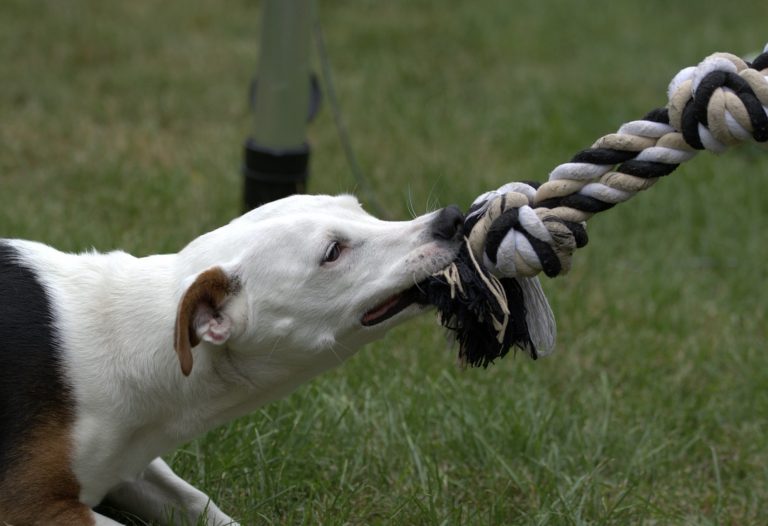Let’s establish the truth first. Dogs do bite. According to statistics, nearly 4.5 million people are bitten by dogs in the US every year.
And if you spend just a little time with your dog, you can reduce that number. Dog owners should be responsible for their pets. No, you cannot get 100% reliability and you cannot guarantee a dog will never bite.
What you can do is eliminate most triggers and teach your dog bite inhibition.
Today, we will talk about why do dogs bite, and which are some of the most common triggers.
Why do dogs bite?
While there are many reasons why do dogs bite, like reacting to a stressful situation, because they are scared, to protect themselves, to protect their owner, and more, most triggers have to do with their body.
And it is simple, do you like strangers touching you? Remember, not all dogs are Labrador Retrievers and Golden Retrievers. While these two breeds are famous for their tolerance to touching and frankly harassment, other breeds are not.
And most triggers have to do with a dog’s body. Those include muzzle, ears, collar, food bowl, and even things like hugging. Dogs do not understand the concept of hugging. They do not understand that when you touch them, you express love. You need to teach them that.
How to teach your dog to love touching?
One of the simplest ways to reduce dog bites and prevent dog bites is to teach your dog to love touching. How to do that?
Well, for starters, you have to hand feed your dog. This helps your dog learn that foods come from you. And once you hand feed your dog, you can use food as motivation and reinforcement for good behavior.
So, with that in mind, here is how to teach your dog to love hugs, touches, and more.
Call your dog, have him sit, and praise him
Pet your dog, and give him a treat
Pet your dog again, and give him another treat
Touch your dog’s ears, and give him a treat
Touch your dog’s nose, and give him a treat
Touch your dog’s muzzle and give him a treat
Touch your dog’s collar and give him several treats, remember this is a sensitive spot, so more treats
Repeat the exercise every day
This works easily when you are handling a puppy. Puppies have no problem with touching as much as older dogs. So, if you are working with an older dog, it is important that you move very slowly. Work on only petting for a while, and then move to touching other parts of his body.
And because children are mostly at risk with dogs, you can teach your dog to love children even more. How? You up the treats. Give children tastier treats. Invite some friends with children to your home. Give the kids some treats like cheese, salami, prosciutto, sausage, and all the good stuff your dog loves. Do this only when your dog has learned touching equals rewards.
Let a kid touch your dog, and then give him a tasty treat. What does your dog learn over time? Kids come, they touch me, and they have the best rewards.
How to teach bite inhibition?
Another important aspect of reducing dog bites is teaching your dog bite inhibition. Why is that? Because with bite inhibition, even if your dog reacts, he will not hurt you or any other person. With bite inhibition, you teach your dog only to mouth people, not bite people.
To work on bite inhibition, you have to have your dog in a calm environment. Bite inhibition teaches dogs to reduce damage when they react.
How to teach that? Here are the steps, but you can read about it in more detail in the article about bite inhibition.
- Start by playing with your puppy, and every time your puppy bites you and hurts you, say “uffff” and stop the play for a while. Ignore him if he pushes and whines, and add a sit command to get him back to calm behavior. Continue to play until your dog huts you again, and repeat the cycle
- Take the process to the next level. Say “ufff” at the harder bites, those that do not hurt you, but they are hard nevertheless. This gives your dog the idea to play gently
- At this point, your dog should only mouth you and you can now teach incidence. You now teach your pet to not bite as often as he likes. Teach your dog the “leave it” command by holding treats in one hand. Give your dog a treat when he backs off. You can teach this easily with a toy. Start a tug game, tell your dog leave it, wait him to back off, and give him a treat
- By now, your dog should know that only you can initiate play sessions. Tug toys work great now. And now, you teach your dog that even though the toy is right there and he sees it, you start the game. Start playing, tell him leave it, and wait for a few seconds. Then, initiate play again
And if your dog does not let the tug toy, stop the play for the day. This will teach him that if he doesn’t let go, you do not play.
Prevent dog bites
Let’s finish off with a couple of tips for how to prevent dog bites. Just like people, dogs can snap. And while people can yell, dogs can bite and cause an incident. Here are some tips to have in the back of your mind:
- Do not approach an unfamiliar animal
- Do not make loud noises or panic when a dog comes to you
- Remain motionless when an unfamiliar dog approaches you
- Avoid direct eye contact with a dog
- Do not disturb a dog while eating, sleeping, or taking care of his/her little ones
- Always allow a dog to sniff you and smell you before you pet him
- Do not encourage aggressive play with your dog







